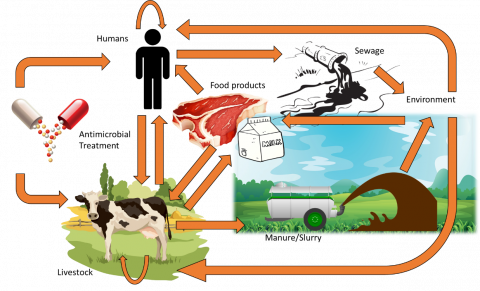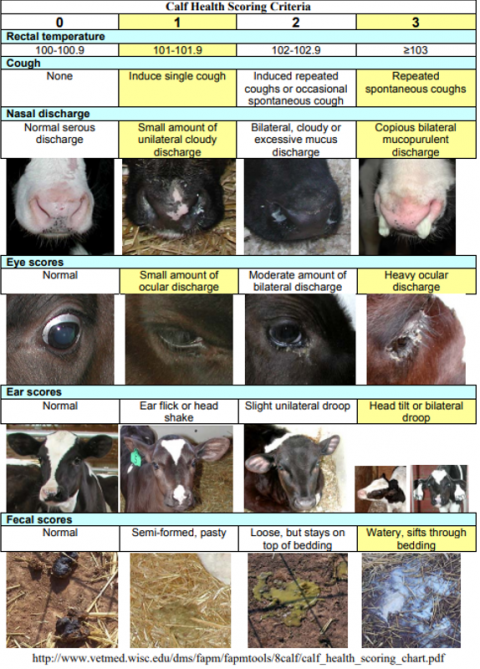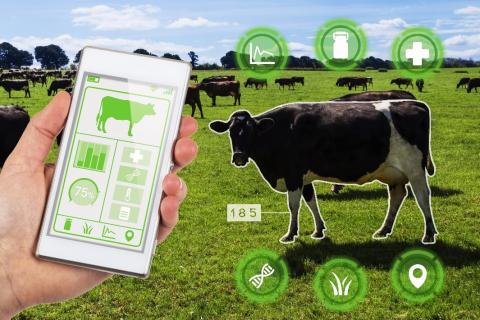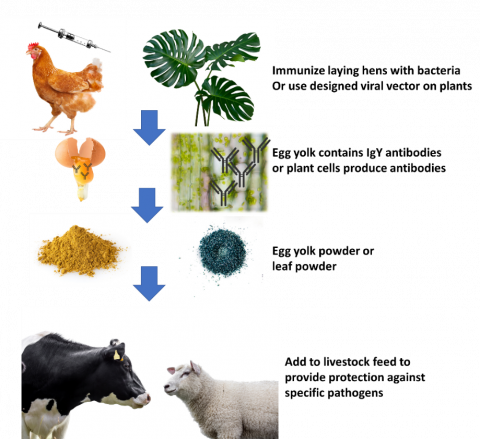17 December 2020
Dr David Cutress: IBERS, Aberystwyth University.
- Antimicrobial resistance is a major concern across human and animal health
- Moving away from blanket antimicrobial treatments is having positive effects on AMR but more focus is needed on implementing best practices on farms
- Precision technologies and future strategies in reducing AMR are in development but will likely have reduced impact compared to improving general farm hygiene, biosecurity and disease controls
The current state of AMR
Antimicrobial resistances are of growing concern in the human health sector. AMR in the UK has been estimated to be of vital concern within the next 30 years, with a review in 2015 suggesting that AMR issues could lead to 10 million human deaths and account for £76.5 trillion deficits in lost output. A global meta-analysis suggested that placing restrictions on antibiotic use has led to a 15% reduction in AMR occurence and a 23 – 32% reduction in the prevalence of multi-drug resistant bacteria in animals. However, strategies, such as antimicrobial use as a growth promoter (now largely banned worldwide), have had a noted effect on increasing the prophylactic use of medications to compensate for animal production losses seen. As such recent European regulations have moved to further limit prophylactic applications of antibiotics in livestock as of 2022. Agricultural and livestock specific impact on AMR was highlighted by the World Health Organization (WHO) when they launched specific guidelines on the use of medically important antimicrobials across the food production industry towards the end of 2017. The logic being that blanket treatments, incorrect application, growth-promotion use and widespread over-use in livestock animals could act as a reservoir for microbes to develop resistance, and ultimately these resistances could be transferred back to human disease-causing microbes. The mechanisms for AMR development across bacteria, fungi, parasites and viruses can be complex but the basics of the principal demonstrated below, for antibiotics, generally hold true across all microbes, but this is by no means the only manner through which resistances can occur.
The use of critically important antimicrobials for human use is of concern as pigs for example share many zoonotic diseases with humans. As such AMR in cross-species infection transmissions could pose a serious risk. Despite this, to date, the specific evidence on transmission of AMR between humans and livestock is limited, many believing it to be prevalent but currently under-researched. Certain routes of potential AMR transmission are presented simplistically below and can occur between the environment, humans, livestock and many other factors in a variety of directions.
This article aims to address some factors of AMR in grazing or partial grazing systems, such as in the beef and dairy cattle and sheep sectors. Diseases which are linked with microbes of high economic importance in cattle include; scouring, bovine virus diarrhoea (BVD), pneumonia, condition losses associated with parasitic infection and lameness. In suckler herds, veterinary treatments account for on average 20 - 21% of annual costs in the UK, a significant amount of which will be antimicrobial related applications. Furthermore, specific studies have shown the impact of antibiotic use early on in suckler calves, with 20.4% of calves shown to require treatments in the first 30 days. In sheep, microbial disease issues include; lameness, associated parasitic condition losses, pneumonia, watery mouth disease and joint ill. Correct nutrient management, particularly around pregnancy and in colostrum application, is also regarded as vital to reducing antimicrobial treatments required. Currently, in Wales there is an animal health and welfare framework (AHWF) which has an AMR implementation planning and delivery group looking to employ a one health approach to combating AMR by linking between animals, the environment and the healthcare sector. Alongside this the UK Government and the Welsh Government have shown continued commitment to a one health approach to combating AMR through their ‘Tackling antimicrobial resistance’ (national UK) and ‘Antimicrobial Resistance in Animals and the Environment’ (Wales) five year implementation plans for 2019-2024.
The main strategies they note at agricultural levels are; good farm management practices, biosecurity, good hygiene practices and appropriate vaccination strategies. Schemes are already underway in Wales utilising these key strategies and encouraging improved knowledge transfer in the form of the ‘Arwain Vet Cymru’ project funded by the rural development programme.
Best practices and biosecurity
When considering AMR within livestock an important consideration is the promotion of animal health (as this will reduce the potential need for antimicrobial treatment) and strategies to improve hygiene (to prevent build up and transmission of microbes). Schemes like ‘Sustainable Control Of Parasites’ (SCOPS) and ‘Control Of Worms Sustainably’ (COWS) demonstrate an understanding of the importance of animal health and reducing antimicrobial treatments for a specific group of microbes. Equally, the ‘Responsible Use Of Medicines In Agriculture’ (RUMA) has a task force aimed at correct, and reduced, antibiotic use in livestock. Whilst other schemes, such as the ‘Healthy feet programme’ run by AHDB, are aiming to improve health and hygiene by reducing the prevalence of specific diseases known to lead to antimicrobial treatment. Strategies as part of farm assurance schemes (such as those required for organic certification, farm assured Welsh livestock ‘FAWL’ and Red tractor quality assurance etc) can play a role in AMR reduction through their requirement for regular reviews of on-farm antimicrobial use via veterinarians. DEFRA committed to targets of antibiotic use, in livestock for food, to be reduced to 50mg/kg by 2018 which was achieved before target deadlines in 2016. In the last veterinary antimicrobial resistance and sales surveillance UK report (VARSS), antibiotic usage had been reduced to 29.5 mg/kg, demonstrating almost double the figures initially desired. However, whilst all livestock areas have demonstrated reductions in antibiotic usage from 2015 to now, in the last report between 2017 and 2018 both poultry and dairy demonstrated an increase in use for this specific year.
Best practice strategies that can demonstrate benefits in improving animal health and therefore reducing antimicrobial treatment include utilising observations such as clinical respiratory scoring charts, body condition scoring (BCS), animal weighing, and rumen fill scoring. Whilst these, and other, observations are generally already performed, adding increased regularity within a management strategy can assist in earlier diagnosis of diseases, to reduce the need for antimicrobial interventions.
Other best practices of consideration involve general hygiene and biosecurity. Diseases can enter farming systems through animal movement and outside purchases. Having on-farm ability to isolate and quarantine incoming (and internal) animals can prevent herd level spread. Worryingly, despite this, studies have shown that 10% of farmers don’t follow correct quarantine procedures after purchasing new sheep. Biosecurity best practices are set out by DEFRA and include both external (infectious entry onto farms) and internal (preventing infectious spread within farms) strategies. Whilst it can be difficult to provide figures to the benefits of specific biosecurity practices, these are well regarded as a major factor in reducing infection and, therefore, antimicrobial treatment requirement. Schemes such as closed herds have been shown to reduce risks of AMR E. coli development in dairy cattle for example. Where indoor housing occurs, this acts as a further risk,as specific cleaning and disinfection protocols must be considered to remove areas which can act as microbial reservoirs. In research conducted into Johne’s disease it was shown that 97% of all farmers re-used calving areas for multiple calvings and 33.7% never cleaned these areas between calving. Encouraging farmers to request veterinary assisted animal health and biosecurity disease planning programmes and providing targeted education and awareness of the issues, have demonstrated positive effects in specific disease management in many instances.
In sheep and cattle, initial colostrum feeds provide transfer of passive immunity to newborns for diseases which could otherwise require antimicrobial treatments or lead to increased mortality rates. Best practices state that optimal colostrum feeds occur within the first four hours of birth (as quality decreases over time) and that colostrum should be tested to ensure quality via refractometers. Equally, in pregnant ewes and cows, in the periparturient period, nutrition can be key in ensuring quality colostrum production. Whilst in cattle little research suggests any specific diets which particularly boost colostrum quality (though supplements such as nicotinic acid show promise), adequate nutrition is vital. In sheep providing corrected nutrition to ewes for the number of offspring is noted as important for best lambing outputs and colostrum quality, with the suggestion that, whilst farmers regularly scan ewes, they often do not then group twins and singles most efficiently to provide optimal nutrient feeds.
Vaccinations are a major strategy in the reduction of antimicrobial resistance as a preventative measure. In humans, the role of vaccines in reducing both disease prevalence and AMR is well documented. Vaccines are an important alternative to antimicrobials in livestock with evidence suggesting improved effectiveness of subunit, DNA and RNA vaccines over more traditional whole pathogen immunisation. Vaccination of cattle and sheep in the last weeks of pregnancy can improve the concentration of antigen-specific antibodies present in colostrum, further boosting calves’/lambs’ protection against certain pathogens including parasite challenge.
Generally, nutrition and health of animals are key to fighting diseases and reducing susceptibility. Illnesses such as milk fever in dairy cattle for example make animals more susceptible to mastitis infections. Dry cow management including selective dry cow therapy rather than blanket treatment and inclusion of effective teat sealant treatments, including new advances into specifically effective antimicrobial teat sealants could also help reduce infections and subsequent antimicrobial treatments. Where grazing animals are farmed there is often direct interaction with on-farm slurry/manure fertiliser which can act as a potential route for AMR microbe presence. Within animal faeces itself AMR microbes can be present, but also microbe interaction and mutation during the slurry/manure storage and processing can lead to AMR developing. Though the “Food Standards Agency” (FSA) suggests treatments to reduce pathogen levels present in slurry, the application of various storage and treatment effects on AMR development has had little to no investigation to date as to the role it could be playing. The investigation, therefore, of management strategies such as closed and open slurry storage, pyrolysis and co-composting of manure with other materials may well require specific consideration with regards to AMR. Finally, animal feed is important for reducing antibiotic supplementation and AMR development. In the past, and in other countries, antibiotic presence in feeds was linked to AMR microbe presence in the environment, with removal from animal feeds resulting in reductions of AMR microbe levels. Optimal feed storage can also prevent bacterial contamination improving the overall health of animals consuming feeds on-farm.
Technology and AMR
Precision farming technologies allow regularity of animal health observations towards a 24/7 monitoring system. In the dairy industry, a review of 490 farmers found that technology adoptions, generally, led to higher milk production values being achieved. This was linked to increased efficiency but importantly the ability to monitor disease and treat animals in a targeted manner to reduce milk yield losses. Accurate monitoring of welfare and targeted treatment can prevent needless antimicrobial applications which could otherwise encourage AMR development. Technologies also allow monitored animals to be more readily identified and separated to prevent disease spread, further reducing antimicrobial treatments. Technologies assisting in this endeavour include behaviour trackers like accelerometers, which have strong roles in improving general animal welfare. Other behaviour trackers can include automatic feeders and changes in any aspect of an individual animal’s “normal” behaviours can often indicate the early onset of disease. Alerts generated from these can be used to make strategic management changes on farms to combat factors causing diseases and illness. Thermal imaging and temperature monitors can detect temperatures of animals themselves and their environment both of which interact to impact on animal health and disease management. Research uses thermal imagery to alert farmers to mastitis development as well as other key diseases in cattle and sheep.
Automation of animal condition observations offers another route to detect changes associated with diseases. Systems such as 2D and 3D cameras, machine learning, automated weigh scales, robotic milking data can all alert farmers earlier to changes which can be acted on to reduce potential antibiotic treatments required. Image analysis tools have regularly been used to detect lameness earlier in research, one of the diseases most regularly associated with antimicrobial applications. Automated weighing has been demonstrated to act as a low labour opportunity to manage animal nutrition in a targeted controlled way and can even act as a disease indication tool, with projects such as STOC+ (HCC) already putting this into practice in Welsh sheep flocks. Furthermore, systems are now becoming common which link automated weigh scales to treatment dosing guns, to ensure animals are not being over or underdosed with antimicrobials, improving the application efficiency whilst saving money and time. AfarCloud’s project integrates image technology into robotic milker stalls to collect additional animal data such as nutritional rumen fill score indications or body condition scoring in an accurate non-subjective manner. Low performing cattle can then be specifically assessed for disease presence. Robotic milking stalls inherently assist farmers in assessing the disease status of cattle and improving treatment plans based on milking yield changes and cow visit data. Oestrus trackers also offer dual-use for general animal health, as unexpected changes in oestrus conditions can be used to highlight health factors such as disease onset earlier.
Near-infrared (NIR) technologies such as handheld NIR4farm assess nutrient levels of feed or faeces to adapt rations towards keeping livestock in the best general health, having an indirect impact in potentially reducing antimicrobial treatment. NIR technologies and electrical conductivity can also monitor total bacterial cell counts in milk, such detection can target treatments in dairy cattle for mastitis and put in place biosecurity strategies to minimise any infectious spread via milking machinery.
Technologies for monitoring and controlling indoor animal housing environments are also increasingly utilising precision. Systems for temperature and gas control via automated ventilation management could help to provide optimal environments for animal health, improving heat stress which is known to be linked to disease occurrence. Furthermore, ventilation and airflow can be key to the transmission of airborne diseases. Precision biosecurity systems, such as those developed by “PigChamps’ Biorisk®”, tracks farmworker-animal interactions to reduce risks and improve management of disease spread. This involves placing Bluetooth devices on staff and having readers placed across a farm, monitoring staff movement. Such systems could easily be adapted to smaller farms and become part of strategies which allow veterinary professionals and farm consultants to provide farmers with accurate biosecurity management strategies based on the data patterns.
Other impacts on AMR
Targeted breeding and genetic modifications offer the potential to develop hardier livestock breeds. Certain breeds are known for inherent resistances in cattle with particular evidence of improved parasite resistant breeds in sheep. Breeding resistant livestock could dramatically reduce the requirement of antimicrobials thus reducing the environment for AMR to develop. Whilst breeding for resistance offers one route, much research is still underway to understand the highly complex nature of antibiotic effects over time (and across breeding programmes) on animal microbiotas and overall health and performance. Having a better understanding of this could help to improve antimicrobial applications in future. CRISPR/Cas gene editing offers a new tool for targeted genetic changes in livestock animals, but also in the microbes of highest risk to AMR. This can be achieved by “cutting out” resistance genes making microbes susceptible to treatment again or to directly cause microbes to die, offering an alternative treatment to antimicrobials.
Bacteriophages are viruses which target bacteria, these can act as tools for highly specific targeting of environmental and in-animal bacteria. Whilst these can encounter spontaneous resistances from the bacteria (just like antibiotics), given as a complex cocktail of phages, targeting slightly different elements of the bacteria all at once makes resistances difficult to develop. Antibiotic conjugates or nanoparticle/nano-encapsulated antibiotics offer improved usefulness over our current suite of antibiotics and potentially reduce the ability for AMR to occur. Antibiotics can be bound to protein antibodies guiding them inside the animal's body directly to the bacteria, this can reduce dosages required and reduce antibiotic interactions with non-desired bacteria which could develop and spread AMR genes. Nano-particles and encapsulation provide medications with a higher surface area for improved activity and increased protection from undesired breakdwon by the animals' natural metabolism, reducing the dosages required. Antimicrobial peptides are promising in combating antibiotic resistances as these show much lower ability for bacteria to develop resistance. Whilst issues surround the ability to make these small molecules stable, their combined use with nano-technologies is beginning to show promise.
Antibody oral application has also been explored for providing protection to diseases in aquatic, avian and mammalian species. These antibodies are generally produced by immunising chickens to produce antibodies in their laid eggs (chick egg yolk antibodies/IgY), or through synthesis within plants. Orally feeding these antibody mixes prophylactically can provide passive immunity responses in livestock protecting them from desired bacteria reducing the antibiotic need and therefore AMR. Eubiotics in the animal feed industry may have roles as a replacement for antibiotics as growth and health promoters. Eubiotics include probiotics, organic acids, prebiotics, enzymes, herbs and essential oils. Whilst many of these are currently doubtful in their effects, probiotics are showing promise and importantly a lack of issue with AMR development.
Summary
Antibiotic resistance is being seen as a developing crisis in both human health and agricultural systems as well as in the interactions between the two with an impact on the surrounding environment as a reservoir. Whilst significant progress has been made towards combating AMR in the UK and Europe several countries lag, failing to implement bans on blanket antimicrobial applications and their use as growth promoters. Antimicrobial use varies across UK farms with some demonstrating dramatically higher usage than should be required. Areas linked to reducing antimicrobial use of importance include maintaining high standards in best practices such as farm hygiene, biosecurity and disease management strategies. It is vital that farmers are aware of these areas and that they seek to develop management plans with informed veterinarian professionals to achieve the highest success. Alternatively, technologies could play an ever-increasing role in improving farm management, the data these provide could be incorporated into improved management strategies for animal health and welfare, leading to reduced disease prevalence, reduced antimicrobial applications and therefore reduced AMR occurrence.




